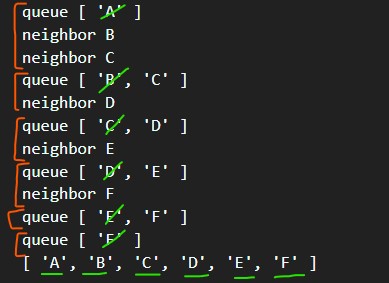[JS 자료구조] 그래프 순회(Graph Traversal) - DFS(깊이우선탐색), BFS(너비우선탐색)
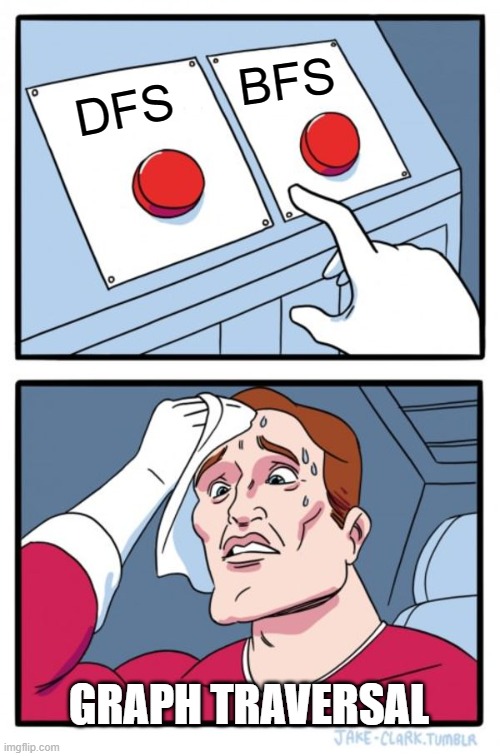
그래프 순회(Graph Traversal)
- 그래프에서 순회하는 코드를 짤 때, 루트가 있는 트리와는 달리 시작점을 정해줘야 한다.
- 그래프의 한 노드에서 다른 노드로 갈 때 유일한 하나의 길만이 있다는 보장은 없다. 이미 방문한 노드를 다시 방문해야 할 수도 있다.
- 그래프 순회 사용 예시
- P2P 네트워킹
- 웹 크롤러
- 최단 거리 찾기
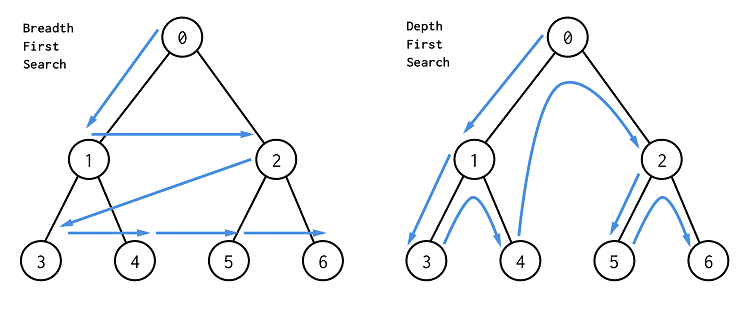
DFS(깊이우선탐색)
Explore as far as possible down one branch before "backtracking”
- DFS(깊이우선탐색)은 다른 형제를 방문( backtracking)하기 전에 한 브랜치에서 가능한 가장 아래까지 깊이 탐색한다.
- DFS와 BFS 모두, 매개변수로 시작점을 받고 순회하면서 방문한 정점을 추적한다는 점들은 같다.
- 아래와 같은 그래프에서 A부터 순회를 시작하는 과정을 살펴보자.
- 방문한 곳들의 노드를 인접리스트에서 지워나가야 한다. 아래 이미지는 A와 B 노드를 방문하고 이제 B에서 다음으로 방문할 노드를 결정해야 하는 상황이다. 인접리스트에는 A와 B가 삭제되어 있다. B에서 다음으로 방문할 노드는 인접리스트[B]에 남아 있는 ‘D’ 가 된다. 이러한 로직을 인접 리스트의 배열(각 정점의 간선)들에서 값이 남지 않을 때까지 반복한다.
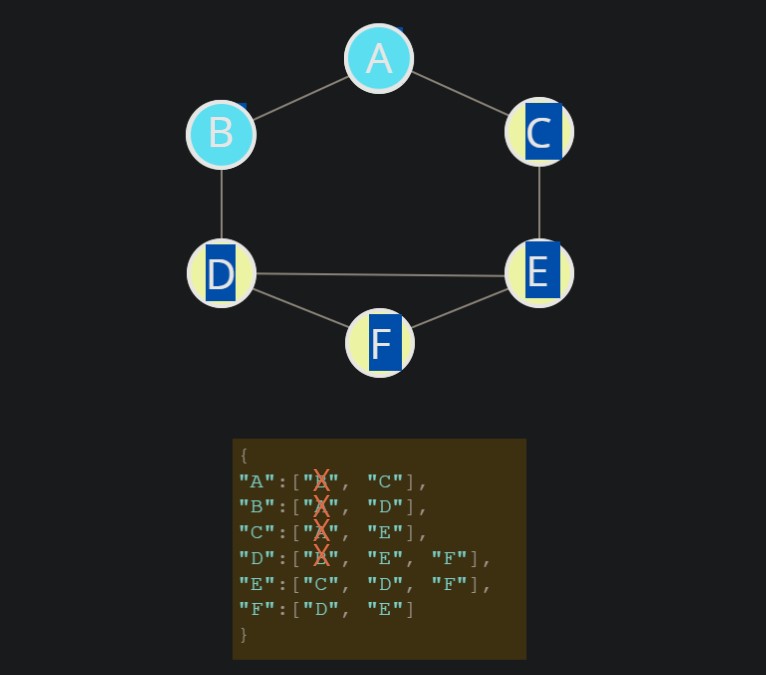
DFS - 재귀형 코드
- depthFirstRecursive 메서드 코드
// 순회를 시작할 정점 노드를 인수로 받는다.
depthFirstRecursive(start) {
// 결과를 저장할 빈 배열 result를 만든다(마지막에 이것을 return할 것이다)
const result = [];
// 방문한 정점들를 기록할 빈 객체 visted를 만든다.
const visited = {};
const { adjacencyList } = this;
// 재귀를 도울 헬퍼 함수를 정의하며, start를 인수로 받아 즉시 실행한다.
(function dfs(vertex) {
// 만약 정점이 비었다면 return 한다.
if (!vertex) return null;
// 방문한 정점을 visited 객체에 true로 기록한다.
visited[vertex] = true;
// 방문한 정점을 result 배열에 추가한다.
result.push(vertex);
// 방금 방문한 정점과 간선으로 이어진 노드 중에서 아직 방문하지 않은 노드들에 대하여
// 본 헬퍼 함수를 재귀한다.
adjacencyList[vertex].forEach(neighbor => {
if (!visited[neighbor]) {
return dfs(neighbor);
}
});
})(start);
// 순회한 정점이 순서대로 담긴 배열 result를 return한다.
return result;
}- 메서드 실행 결과 확인
const g = new Graph();
g.addVertex("A");
g.addVertex("B");
g.addVertex("C");
g.addVertex("D");
g.addVertex("E");
g.addVertex("F");
g.addEdge("A", "B");
g.addEdge("A", "C");
g.addEdge("B", "D");
g.addEdge("C", "E");
g.addEdge("D", "E");
g.addEdge("D", "F");
g.addEdge("E", "F");
// A
// / \
// B C
// | |
// D --- E
// \ /
// F
// 위와 같은 그래프에서 A부터 순회를 시작하도록 depthFirstRecursive('A') 메서드를 실행하면, 마지막 줄과 같이 예상한대로 순회했음을 확인할 수 있다.
console.log(g.depthFirstRecursive("A"));
// [ 'A', 'B', 'D', 'E', 'C', 'F' ]DFS - 순환형 코드
- depthFirstIterative 메서드 코드
depthFirstIterative(start) {
// stack 배열을 정의하고, start 노드를 추가한다.stack은 반복문에서 조건으로 사용할 것이다.
const stack = [start];
// 결과를 저장할 빈 배열 result를 만든다(마지막에 이것을 return할 것이다)
const result = [];
// 방문한 정점들를 기록할 빈 객체 visted를 만든다.
const visited = {};
let currentVertex;
// visited 객체에 start 노드는 방문했음을 기록한다.
visited[start] = true;
// stack이 비어 있지 않은 한, 무한 루프를 돌린다.
while (stack.length) {
// 여기서는 pop을 이용하여 간선 배열의 끝에서부터 정점을 꺼내어 방문한다.
// stack에서 가장 최근에 들어온 노드를 하나 꺼내어(pop), currentVertex 변수에 할당한다.
currentVertex = stack.pop();
// 지금 방문한 정점을 result 배열의 마지막에 추가(push)한다.
result.push(currentVertex);
// 지금 방문한 정점과 간선으로 이어진 정점 중
this.adjacencyList[currentVertex].forEach(neighbor => {
// 아직 방문하지 않은 이웃 정점에 대하여
if (!visited[neighbor]) {
// visited 객체에 이제 방문했음을 기록하고
visited[neighbor] = true;
// stack 배열(while문 종료 조건이었죠~)에 push한다.
// stack에는 이제 start 정점은 없고 그 다음에 방문한 정점 하나가 있게 되며, 다시 while문을 돈다.
stack.push(neighbor);
}
});
}
// 반복문이 다 종료된 후 result를 반환한다.
return result;
}- 코드 실행 결과
- 코드의 작동 방식 때문에, 재귀형 코드와 달리 순회 순서가 달라지긴 했으나, 두 방법 모두 DFS 방식인 것은 동일하다.
class Graph {
constructor() {
this.adjacencyList = {};
}
// 기타 메서드 생략
depthFirstIterative(start) {
const stack = [start];
const result = [];
const visited = {};
let currentVertex;
visited[start] = true;
while (stack.length) {
console.log("stack", stack); // 이해하기 위해 콘솔로그 찍음
currentVertex = stack.pop();
result.push(currentVertex);
this.adjacencyList[currentVertex].forEach(neighbor => {
if (!visited[neighbor]) {
console.log("neighbor", neighbor); // 이해하기 위해 콘솔로그 찍음
visited[neighbor] = true;
stack.push(neighbor);
}
});
}
return result;
}
}
const g = new Graph();
g.addVertex("A");
g.addVertex("B");
g.addVertex("C");
g.addVertex("D");
g.addVertex("E");
g.addVertex("F");
g.addEdge("A", "B");
g.addEdge("A", "C");
g.addEdge("B", "D");
g.addEdge("C", "E");
g.addEdge("D", "E");
g.addEdge("D", "F");
g.addEdge("E", "F");
// A
// / \
// B C
// | |
// D --- E
// \ /
// F
// 위와 같은 그래프에서 A부터 순회를 시작하도록 depthFirstIterative('A') 메서드를 실행하면, 마지막 줄과 같이 순회했음을 확인할 수 있다.
console.log(g.depthFirstIterative("A"));
// [ 'A', 'C', 'E', 'F', 'D', 'B' ]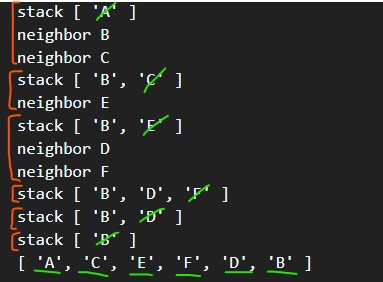
BFS(너비우선탐색)
- BFS(너비우선탐색)은 현재 같은 높이(height)의 이웃 정점들을 먼저 방문하는 알고리즘이다.
- 아래 코드에 주석을 달긴 했지만, BFS 순환형 코드는 DFS 순환형 코드와 거의 비슷한다.
- 다른 점은 while 조건문에서 순회하는 개념으로 stack 대신 queue를 사용하고 이를 위해 pop 메서드 대신 shift 메서드를 쓴다는 것이다.
breadthFirst(start) {
const queue = [start];
const result = [];
const visited = {};
let currentVertex;
visited[start] = true;
while (queue.length) {
// 여기서는 shift를 이용하여 간선 배열의 처음부터 정점을 꺼내어 방문한다.
// queue에서 줄 제일 앞에 서 있는 노드를 하나 꺼내어(shift), currentVertex 변수에 할당한다.
currentVertex = queue.shift();
result.push(currentVertex);
this.adjacencyList[currentVertex].forEach(neighbor => {
if (!visited[neighbor]) {
visited[neighbor] = true;
queue.push(neighbor);
}
});
}
return result;
}- 코드 실행 결과
class Graph {
constructor() {
this.adjacencyList = {};
}
// 기타 메서드 생략
breadthFirst(start) {
const queue = [start];
const result = [];
const visited = {};
let currentVertex;
visited[start] = true;
while (queue.length) {
console.log("queue", queue); // 이해하기 위해 콘솔로그 찍음
currentVertex = queue.shift();
result.push(currentVertex);
this.adjacencyList[currentVertex].forEach(neighbor => {
if (!visited[neighbor]) {
console.log("neighbor", neighbor); // 이해하기 위해 콘솔로그 찍음
visited[neighbor] = true;
queue.push(neighbor);
}
});
}
return result;
}
}
const g = new Graph();
g.addVertex("A");
g.addVertex("B");
g.addVertex("C");
g.addVertex("D");
g.addVertex("E");
g.addVertex("F");
g.addEdge("A", "B");
g.addEdge("A", "C");
g.addEdge("B", "D");
g.addEdge("C", "E");
g.addEdge("D", "E");
g.addEdge("D", "F");
g.addEdge("E", "F");
// A
// / \
// B C
// | |
// D --- E
// \ /
// F
// QUEUE: []
console.log(g.breadthFirst("A"));
// RESULT: [A, B, C, D, E, F]메서드 내부에서 실행된 콘솔로그까지 포함한 코드 실행 결과는 아래 이미지와 같다.
queue에서 제일 앞 정점부터 초록선으로 shift하며 순회하는 모습이다. 지금 방문한 정점과 간선으로 이어진 정점들을 돌리는 forEach문에서 queue에 push되는 정점들이 neighbor 옆에 찍혔다.
